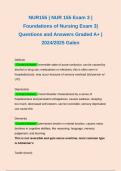NUR155 | NUR 155 Exam 3 |
Foundations of Nursing Exam 3|
Questions and Answers Graded A+ |
2024/2025 Galen
Delirium
- Correct Answer - reversible state of acute confusion, can be caused by
alcohol or drug use, medications or infections, this is often seen in
hospitalized pts, may occur because of sensory overload (old person w/
UTI)
Depression
- Correct Answer - mood disorder characterized by a sense of
hopelessness and persistent unhappiness, causes sadness, sleeping
too much, decreased self-esteem, can be reversible, sensory deprivation
can cause this
Dementia
- Correct Answer - permanent decline in mental function, causes many
declines in cognitive abilities, like reasoning, language, memory,
judgement, and learning.
This is not reversible and gets worse overtime, most common type
is Alzheimer's
Tactile (touch)
,- Correct Answer - test temp of bath water, monitor extremities, Q2 turns
Olfaction (smell) and gustation (taste)
- Correct Answer - encourage well balanced diet, serve highly aromatic
foods, oral hygiene, enhance flavors, encourage varieties
Auditory
- Correct Answer - encourage use of hearing aids, minimize background
noise, speak clearly, face the pt when speaking
Equilibrium
- Correct Answer - instruct pt to call for help, keep lights dim, floor clear
of any obstacles, keep basin at bedside for nausea and vomiting
Vision
- Correct Answer - orient pt to placement of things in room, call light
within reach
Risk factors for skin breakdown
- Correct Answer - -diabetes (loss of sensitivity, may not know they have
a wound)
-cardiovascular disease (COPD, heart failure)
-malnutrition (decreased protein intake)
-age (older people are more at risk)
-friction and shear, sliding, tearing <- this tears the skin
Risk factors affecting wound healing
- Correct Answer - -oxygen & tissue perfusion
-diabetes
, -nutrition (protein, vit C/A/E, zinc copper)
-age
-infection (affects ability to heal)
-fecal & urinary incontinence
Risk factors for developing pressure injury
- Correct Answer - -boney prominence
-decreased lean body mass
-decreased pain perception
-hyperthermia (fever)
-age
Phases of wound healing
- Correct Answer - inflammatory, proliferative, maturation
Phases of Wound Healing: Inflammatory Phase
- Correct Answer - bodys initial response to wounding of the skin, lasts
about 3 days, bleeding occurs which is known as coagulation cascade
and formation of clot begins, which stops the bleeding, includes process
of homeostasis, there is an increase of pain, swelling, & redness
Phases of Wound Healing: Proliferative phase
- Correct Answer - repair the defect, filling the bed with granulation tissue
(new tissue, beefy red, granular, bumpy, fragile), lasts several weeks
Phases of Wound Healing: Maturation phase
- Correct Answer - known as the remodeling phase, usually lasts up to a
year, scar tissue is formed and strengths (avascular mass of collagen)




